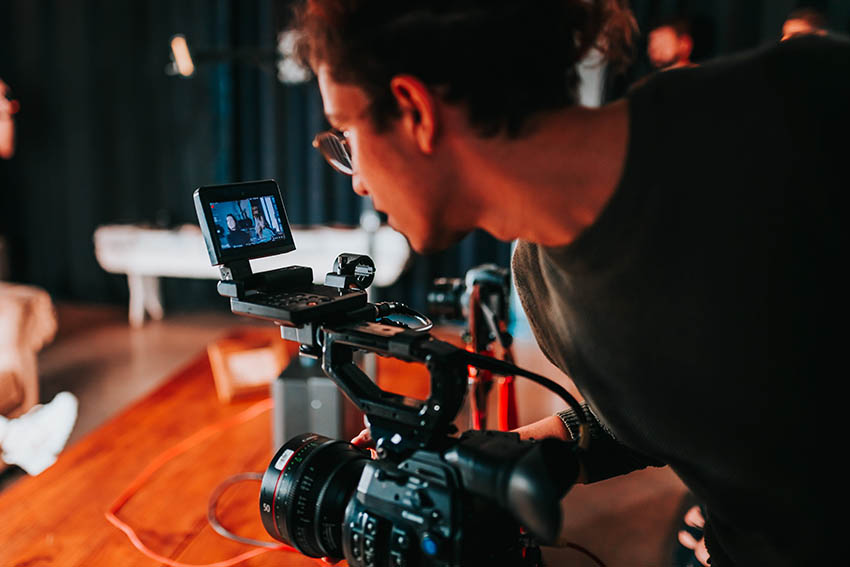So, you’re taking on a remote project. Maybe this is your first one, or maybe you’re just looking for ways to make your remote filmmaking workflow more effective.
As a filmmaker, a lot of what you do can be transferred really well into the digital world. Although when it comes to building a kick-ass remote workflow for your filmmaking project, you might still ask yourself the best way to get some steps done when you’re far away from your client and team members.
These tips will help you to feel better prepared as you organize and execute your remote project and help you to pick the best solutions for you and your team.
1. Create shared documents

The biggest hack when taking on a remote project is to make sure you have a shared document communicating the important decisions taken at any stage in the process. This could take the shape of a creative brief, production meeting notes, or gear lists. When it comes to communicating visual decisions, you may find moodboards and storyboards useful. You may also need to create more technical documents, such as your shooting day schedule or your timeline.
When it comes to managing these files, there is a range of free tools to help you. A platform like Google Drive can offer a great space for you and your team to access important documents at any time, and even collaborate on them where necessary.
2. Keep Notes of all of your meetings & decisions
Most of the time, big decisions will be made through meetings and other conversations. Before sharing that decision in a final document, keep notes of the topics discussed and the solutions chosen during that meeting. You can present it in a shared text document that the team can always refer back to and refresh their memory.
On remote projects, it’s more important than ever to over-communicate so that everything is explicit. Your notes are another way to do this and will avoid confusion later down the line.
3. File organization and Folder Structure
Whether you choose Google Drive or another file organization tool, you should aim to name and organize your files using the same file structure every time. When you do this you increase the chances of everyone being able to find what they need when they need it, without wasting time browsing.
When it comes to organizing your project folder, come up with a list of broad categories for intuitive file navigation. Production Planning and Video Assets are examples of two folders that most filmmakers will need. Within the Assets folder, for example, you can create more folders for assets such as Graphics, Video, Audio, and anything else you may need.
You should then split your assets into more specific categories, like the name of the camera used, shoot days, Music, SFX… it depends on the needs of you and your project. A well-organized Assets folder, in particular, will speed up your work in post-production when you can download, click and drag the folder straight into your editing software.
When you want to organize a set of files chronologically, add the date and time of the file’s creation as a prefix to its name (like “2020-1-1_14-36_YourFileName”). You can use this on the footage to understand the chronology of when it was shot. As well as being intuitive to locate files, it speeds up your ability to find that one clip you know you filmed just before going on your lunch break on production day. You get the idea.
To take this tip one step further, look into creating a keyboard shortcut on your computer. This means that you won’t have to enter the date and time manually to your file name but can use a hotkey instead. Think of how much time that could save you!
4. Main Project Communication Tools

It goes without saying that today when you manage a project remotely, you’re going to be relying a lot more on technology. This isn’t a bad thing in and of itself, but remember that you and your team might be much more tech-savvy than your client.
You need to take this into consideration as you choose the tools that you’ll use for client communication, and project management if the client will participate in that stage, too. If it’s practical to do so, you may want to think about the types of tools your client demographic already uses or will find intuitive.
Some useful tools for organizing tasks and timelines include Asana and Trello. When it comes to quick communication platforms, Slack is used by teams around the world for quick written text communication and casual file sharing. Google Hangouts is great for quick video calls or text messages. Chanty is also a popular tool with remote teams and synthesizes a lot of the features of Slack, Google Hangouts, and a project management tool.
For organizing your files, Google Drive is a great choice. Dropbox is another similar tool that, like Google Drive, lets you share your files with clients and team members and collaborate on documents with them.
5. FAQs
Sometimes you can forget just how much goes into your project that might not be common knowledge. Whether it’s your client or a team member, there might be someone working on the project who is new to filmmaking. If that’s the case, you can be sure they’ll have a lot of questions about the process.
That’s why it can save you a lot of time if you create a shareable FAQ resource. This could be a page on your website or even a shared document. Share it whenever you have a new client or someone joins the team, it’ll save you time and sanity from having to repeat yourself.
6. Remote Contributors for your Film

It’s becoming more common to have external contributors to film projects, and they may or may not have filmmaking experience. In both situations, your contributor needs some kind of direction to understand how to achieve your creative vision.
Think about their level of know-how, and what you need to teach them so they can create the footage needed. It’s now time to compile the information that will bridge that gap, and turn it into a shared resource that they can view.
Video can be a great format for this since you actually show your contributor(s) an example of what you’re expecting. Create a video that lets your contributor follow along as you demonstrate, rather than just explain, how to set up and capture the footage. The amount of detail you go into is up to you, but consider this instruction as one of your new responsibilities in the production stage of a remote project!
7. Remote Editing and Revisions
Communicating what edits need to be made to your rough cut can get confusing. Luckily there are tools that make this stage easier. In fact, you might find you prefer using a tool to reviewing a cut with the client in person. Consider Motion Array’s video review and collaboration platform.
Motion Array is the all-in-one video makers platform with royalty-free music, video templates, stock video, and more including Review. Review is one of these tools that exist to make revisions easier. It allows your client to add comments at specific timecodes of your video, and even add markers on the frame.
These markers make it clearer which part of the frame their comment refers to. It’s still good practice to help your client understand how to read and refer to a timecode. However, this tool will undoubtedly make it easier for even the least tech-savvy client to give clear feedback.
You might still have moments where nothing beats speaking person-to-person. So be prepared to hop on a phone or video call, particularly when you or your client are having trouble communicating visual changes by written text.
If it’s your first time working in remote filmmaking, there will be plenty of lessons you’ll learn along the way. Hopefully, by following these tips you’ll find that the learning curve isn’t quite as steep!
Remember that at the end of the day the tools and tricks you use to build your workflow should be inspired by how you would like to interact in person. Although who knows, maybe when you perfect your remote workflow, you’ll realize that it works even better than your in-person one?
[source: Motion Array]
Disclaimer: As an Amazon Associate partner and participant in B&H and Adorama Affiliate programmes, we earn a small comission from each purchase made through the affiliate links listed above at no additional cost to you.

